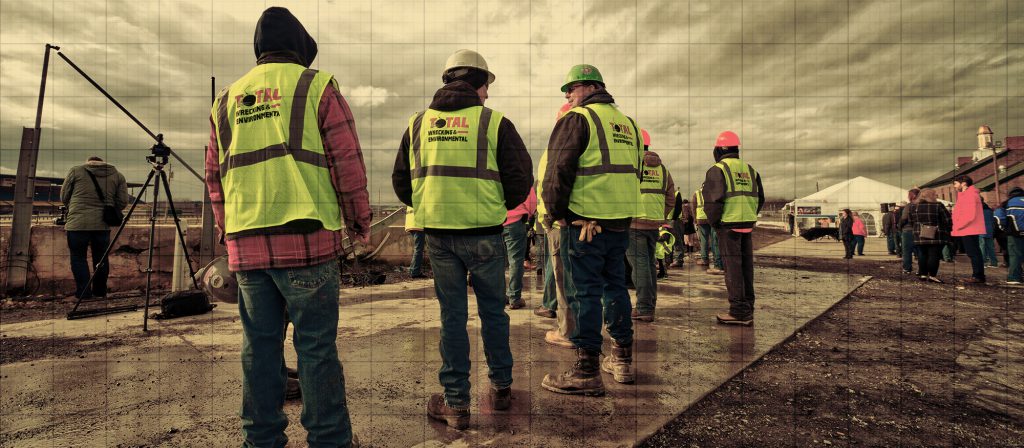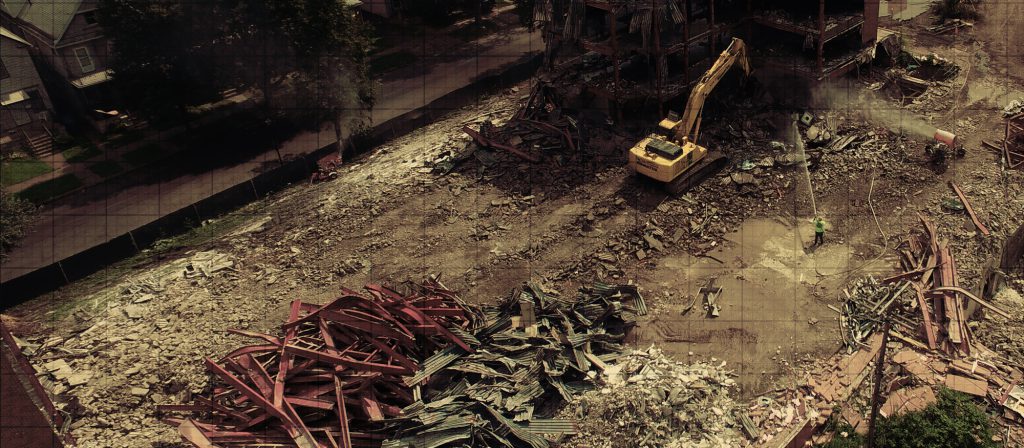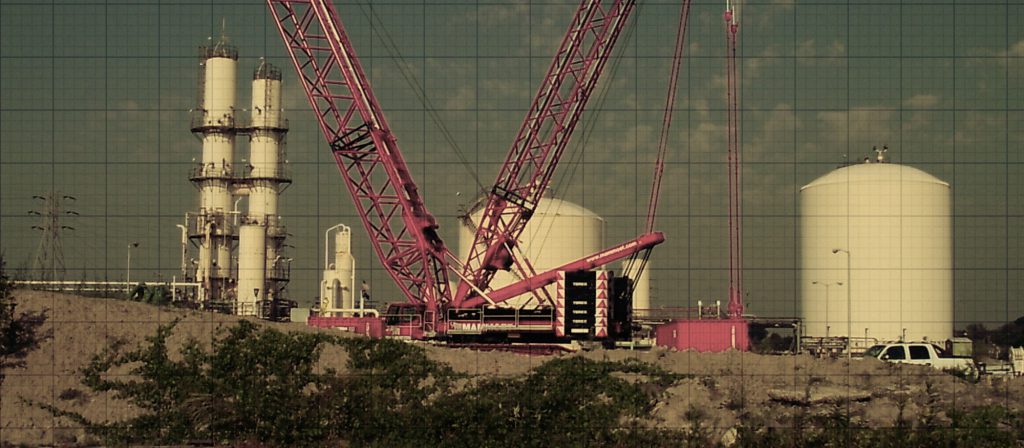Some industrial demolition contractors, and construction companies in general, use safety as a selling point rather than a fundamental workplace practice. Agencies like the Occupational Safety and Health Administration, or “OSHA,” however, are one of the few groups that not only define universal and industry-specific safety standards but also conduct workplace inspections and publish public reports to hold businesses accountable.
But how do these safety procedures affect industrial demolition contractors on both day-to-day and long-term levels? And what relevance do their inspections or recorded incidents have over the viability of a business?
Take a deep dive into our comprehensive OSHA overview to learn the importance of the agency’s work within the industrial demolition contractors community and how crucial they are in determining a business’s level of safety.

What Does “OSHA” Mean?
The Occupational Safety and Health Administration, known more commonly as “OSHA,” is a regulatory agency within the United States Department of Labor. Their primary job is to ensure that employers are providing safe and healthy working conditions for their employees, along with any relevant training, outreach, education, or assistance that enables them to work safely and comfortably.
OSHA was established in 1970 under the Nixon administration and originally had federal visitorial powers to perform random workplace inspections. Today, their universally upheld guidelines and workplace examinations continue to show quantifiable reductions in overall injury rates without any adverse effects on employment, sales, credit ratings, or business viability.
Great. But What Does OSHA Actually Do?
The easiest way to concisely outline OSHA’s role is to look at all of the rights and responsibilities that are detailed in the OSHA Act Law.
At the highest level, the OSHA Act Law summarizes an employer’s responsibility to provide a safe workplace that poses no serious hazards and adheres to all of OSHA’s Safety and Health standards. This also means employers have a legal obligation to eliminate or reduce hazards by making adjustments to the working conditions before relying on personal protective equipment to mitigate risks.
In the context of industrial demolition, this means that contractors are required to use safer chemicals whenever possible, enclose processes that may produce errant fumes, and/or use ventilation systems to clean the air. These are just some examples of how employers can (and should!) be taking effective steps towards eliminating or reducing overall risk to employees.
Diving into the more granular specifics, the Act Law stipulates that Employers have the responsibility to:
- Inform workers about any and all potential hazards
- Provide safety training in relevant areas and in all necessary languages
- Record all work-related injuries and illnesses
- Perform regular health and safety tests within work environments (ex. air quality)
- Provide personal protective equipment (PPE) for free to all employees
- Provide medical tests (when required by OSHA standards) for free to all employees
- Publically post OSHA Job Safety & Health poster that describes rights and responsibilities
- Post all OSHA citations, including annual summaries of injury and illness data, in a public place visible to all employees
- Notify OSHA within eight hours of a workplace fatality, or within 24 hours of all work-related inpatient hospitalizations
In addition to the employer’s responsibilities, the Act Law also details how Workers have the right to:
- Working conditions that pose no risk of serious harm
- File confidential complaints to OSHA to have their workplace inspected
- Receive information and training about hazards, harm prevention methods, and OSHA standards relevant to their workplace
- Receive records of work-related injuries and illnesses, workplace medical records, and workplace testing and monitoring
- Participate in OSHA inspections and speak privately with OSHA inspectors
- File a complaint if they face discrimination for requesting an inspection
- File a complaint if punished for “whistleblowing”

Are There Any “Rights and Responsibilities” Unique to Industrial Demolition Contractors?
Yes! The rights of employees and responsibilities of employers listed above are applicable to any and every work place across the United States, but there are supplemental stipulations unique to specific industries that cover more granular and unique circumstances.
Because industrial demolition falls within the larger “Construction” umbrella, the OSHA outline for Construction, General Industry, Maritime, and Agricultural Standards was specifically created for the construction industry to protect workers from a wide range of serious hazards.
Some of the most pertinent standards listed in the Construction Industry outline include:
- Fall-protection measures such as safety lines, safety harnesses, and guard rails
- Prevention of trenching cave-ins
- Prevention of exposure to deadly diseases
- Prevention of exposure to harmful chemicals
- Additional safety measures for workers in confined spaces
- Additional safety precautions for dangerous machinery
- Providing respirators or other safety equipment
- Providing additional training for certain dangerous jobs
How Are All of These Rights and Responsibilities Enforced?
It is OSHA’s sole responsibility to regulate and enforce their own standards. With a staff of around 2,400 inspectors nationwide, including state partners, this is a relatively small team charged with the responsibility of keeping around 8 million workplaces and 130 million employees safe.
Inspections are performed by trained compliance officers, either on-site or over the phone, and without any advance notice to the employer. These random inspections are scheduled based on their level of perceived danger and prioritized based on the below categories:
- Imminent Danger
- Catastrophes (Fatalities or Hospitalizations)
- Worker Complaints/Referrals
- Targeted Inspections (Hazards/High Injury Rates)
- Follow-Up Inspections
In an average year, OSHA conducts roughly 83,000 workplace inspections where they identify and assess violations and issue fines of up to $13,000 per offense. That may seem like a drop in the bucket compared to how many workplaces exist, but the proof is very much in the pudding. These efforts have had a positive workforce-wide effect since their inception, resulting in an overall reduction in workplace injuries, illnesses, and fatalities.
Tracking and investigating workplace injuries, and making those records both available and accessible to the public, plays a massive role in preventing future injuries and illnesses. In fact, OSHA’s record keeping regulation require employers in high-hazard industries, like industrial demolition, to prepare and maintain all records of workplace injuries. This information is the bedrock of employees’, OSHA’s, and the employer’s understanding of how safe their workplace is.
Access to these records, and a fundamental understanding of their importance, is crucial to understanding the safety of a work environment and implementing protections, procedures, and regulations in place that reduce, or ideally eliminate, the risk of future hazards.

What is an Experience Modification Rate (EMR)?
An Experience Modification Rate, or EMR, is an insurance company metric that quantifies the likelihood that a business will incur worker’s comp claims. In simpler terms, it’s a comparison of a business’ injury rate versus other businesses within its industry.
The average EMR within any industry, including industrial demolition contractors, is a 1.0, where contractors with lower injury rates fall below 1.0 and those with higher injury rates will rise above a 1.0. To calculate an EMR, the National Council on Compensation Insurance (NCCI) divides a company’s payroll classification by 100, and then divides that figure by a “class rate” that reflects the business’s potential risk factor.
OSHA violations, or “recordables,” have a direct impact on an industrial demolition contractor’s EMR rating. Much like any traffic violation will have an affect on your car insurance premium, each workplace incident has a direct impact on your EMR, no matter how small. If an incident is reported by OSHA, your EMR will absolutely be affected.
As will the viability of your business. After all, no one wants to work with an unsafe industrial demolition contractor with a history of reported incidents, which is exactly what any contractor with a high EMR will project. Not only will their insurance rates skyrocket, if they’re still able to be insured at all, but potential clients will almost certainly want to work with a safer and more trustworthy contractor.
What Do Public OSHA Records Say About Total Wrecking & Environmental?
Total Wrecking & Environmental is extremely proud of its flawless safety record and industry-low EMR rating. We are one of the very few companies in the entire industrial demolition business who can confidently say that we have not had any permanent recordables in our company history.
The more we shared this fact with potential clients, however, the more we were met with a “yeah, right” indifference, as if it was a tired line used by every nationwide demolition contractor they’d spoken with. So rather than continue to “tell” our customers, we looked for an opportunity to “show” them and let the publicly available data do the talking for us.
Click here to see all public recordables for Industrial Demolition Contractors across the country. Simply search the company whose history you’d like to see and the search tool will do the rest for you.

